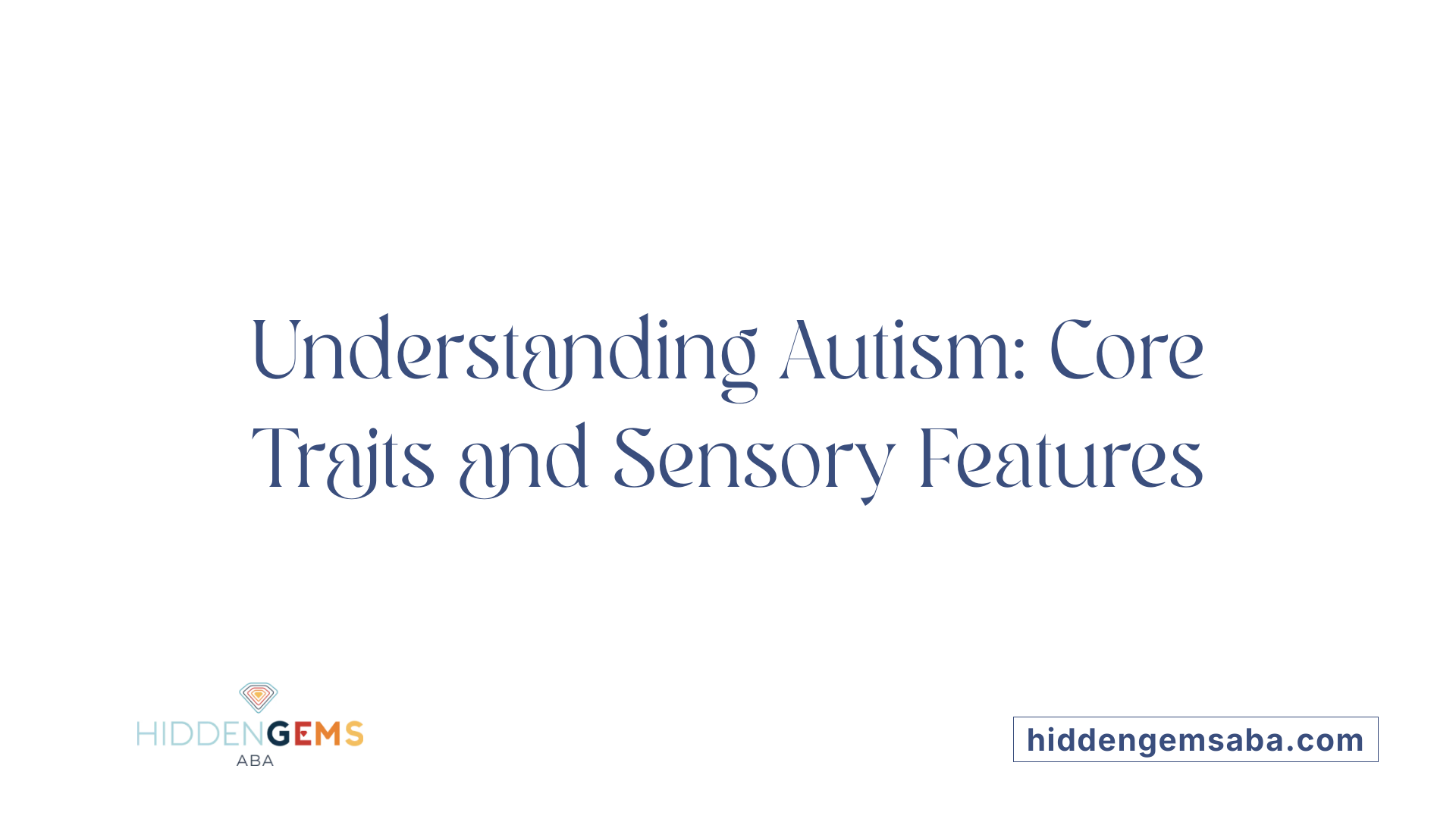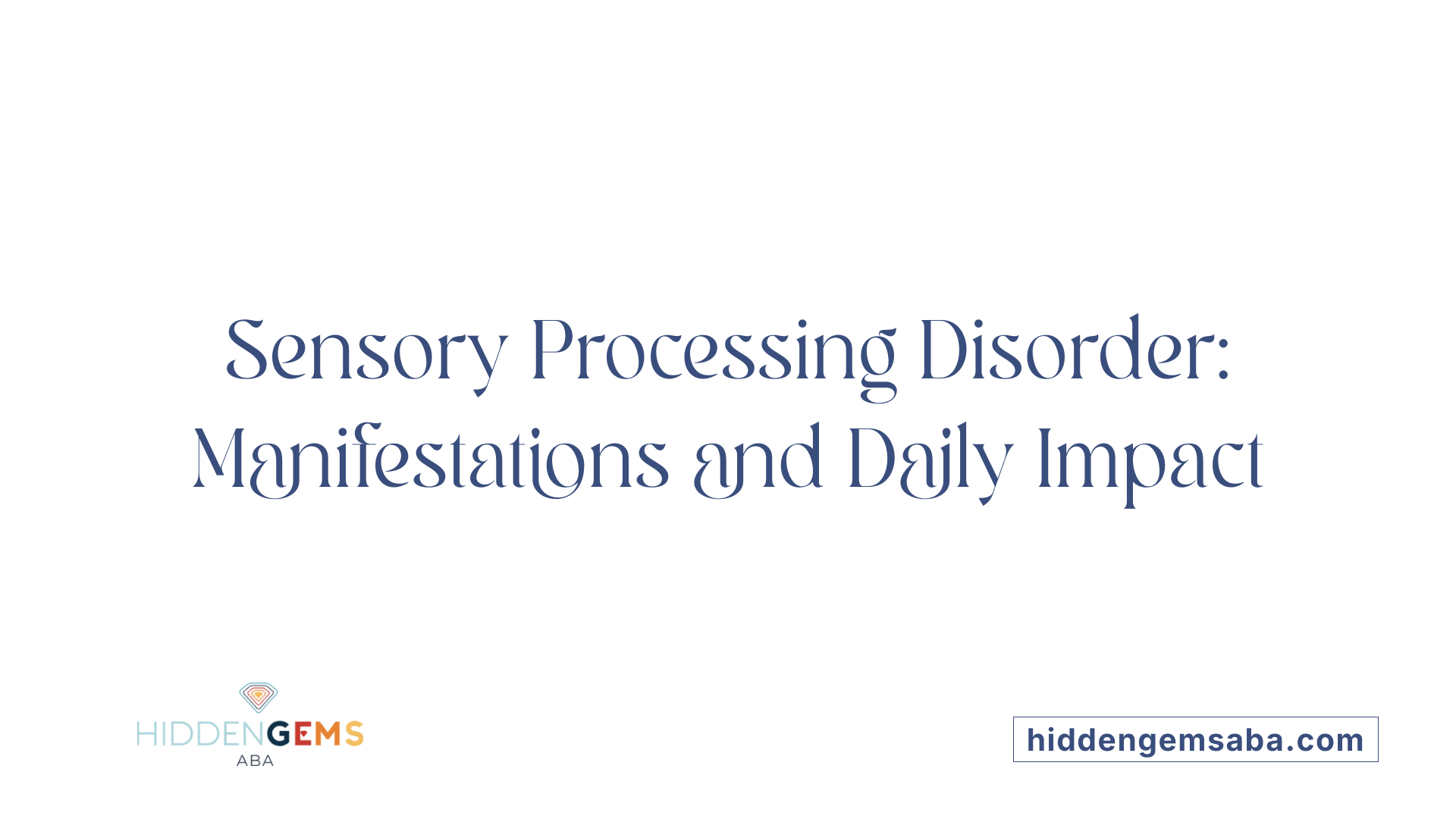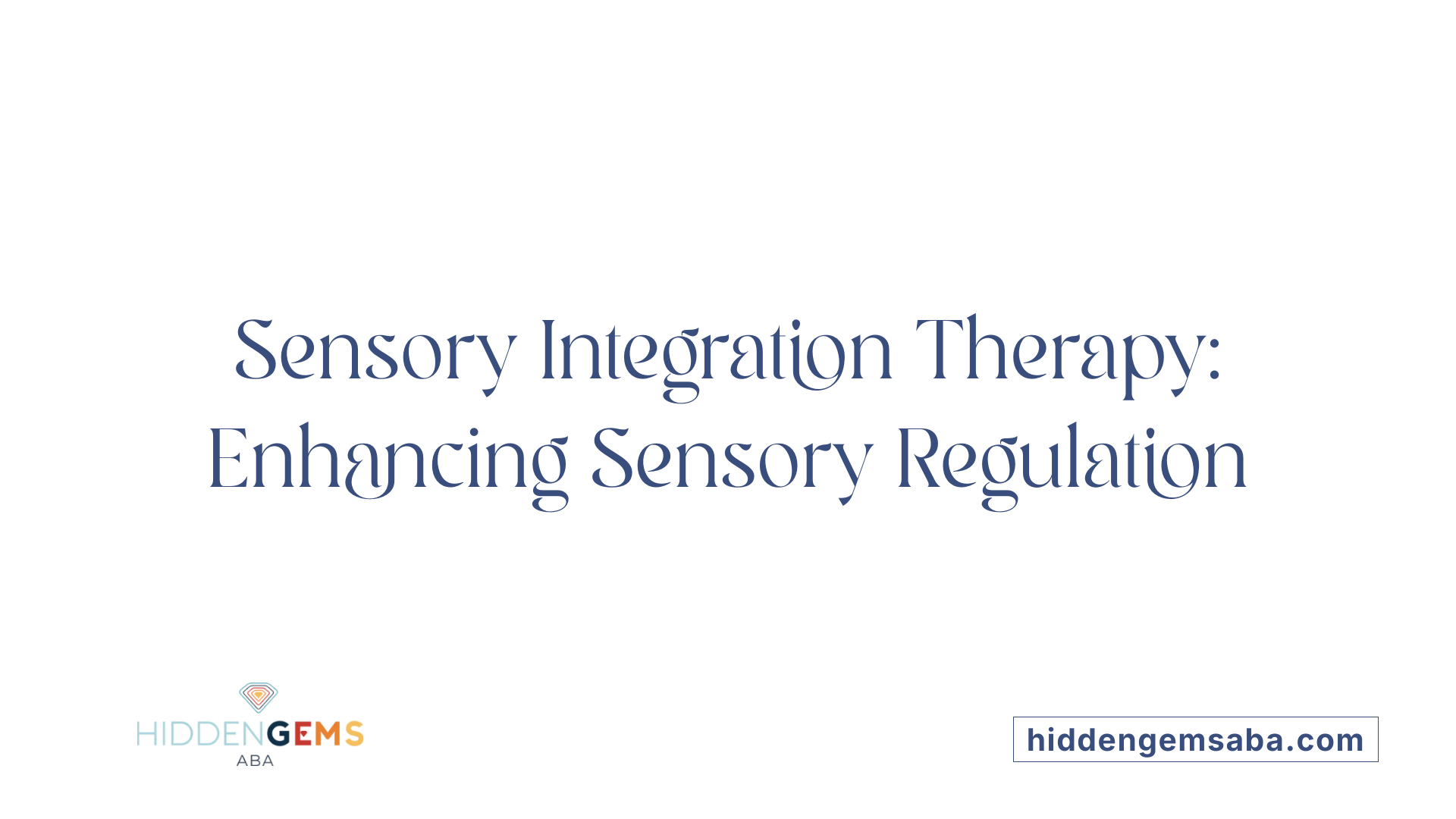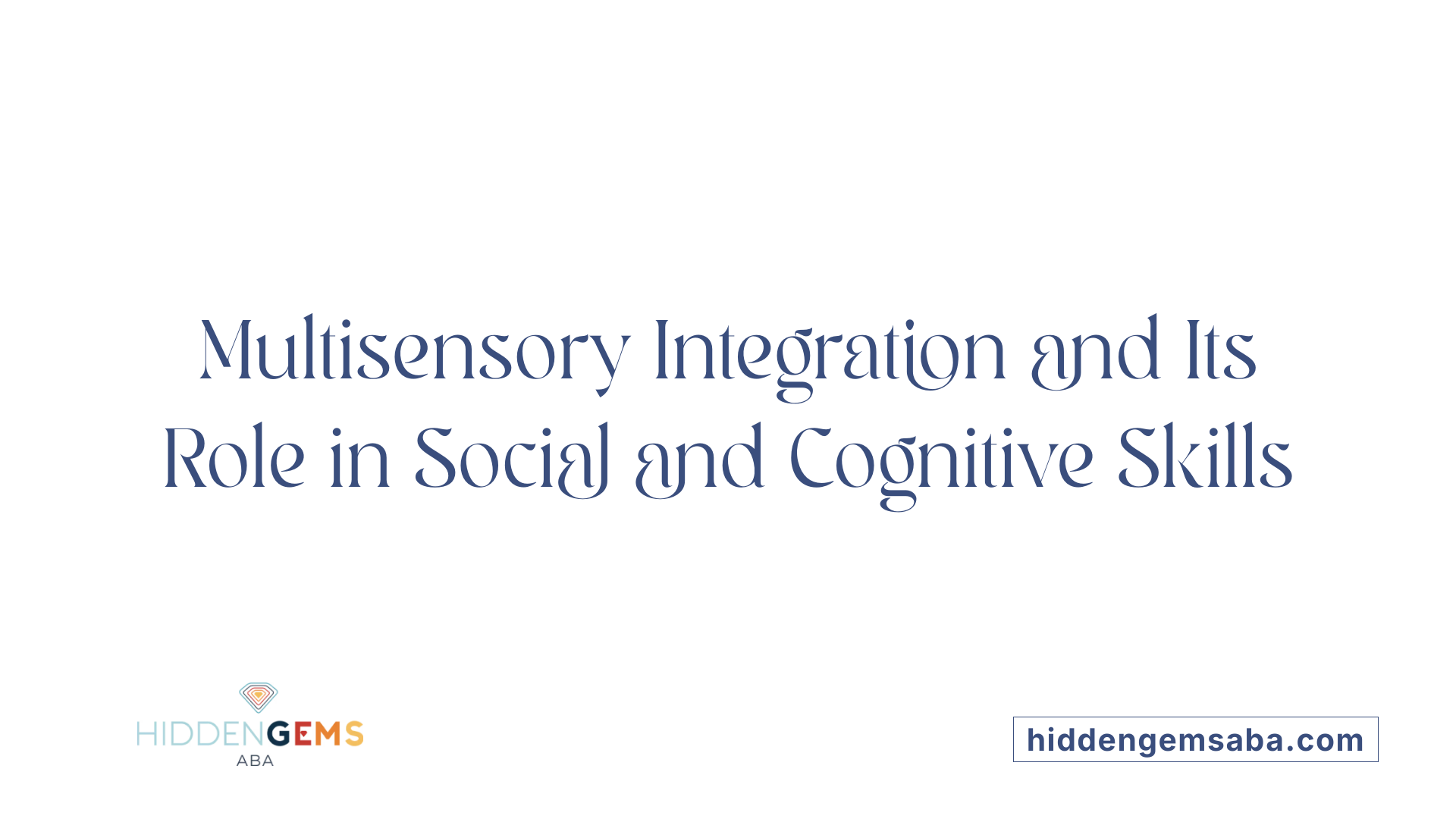Differentiating Sensory Processing Disorder and Autism Spectrum Disorder
Sensory Processing Disorder (SPD) and Autism Spectrum Disorder (ASD) share many overlapping features, particularly in how sensory information is perceived and processed. However, they are distinct conditions with important differences in characteristics, underlying mechanisms, and treatment approaches. This article explores sensory processing challenges within and outside of autism, examining behavioral and physiological profiles, neurobiological underpinnings, and intervention strategies to support individuals with these conditions.
Autism Spectrum Disorder: Core Characteristics and Sensory Features

What are the defining characteristics of Autism Spectrum Disorder?
Autism Spectrum Disorder (ASD) is a developmental disorder that typically manifests in the first three years of life. It is primarily characterized by challenges in social communication and interaction, alongside restricted and repetitive behaviors. In addition to these core features, ASD encompasses differences in sensory processing, which markedly affect daily functioning.
Sensory processing differences included in DSM-5
Sensory processing differences are now officially recognized within the DSM-5 criteria for ASD. These include:
- Sensory hyperreactivity: over-responsiveness to sensory stimuli, such as covering ears in response to sounds or resisting certain textures.
- Sensory hyporeactivity: under-responsiveness, like not reacting to loud noises or pain.
- Sensory seeking behaviors: excessive engagement with particular sensory stimuli, for example, frequently seeking certain sights or sounds. Such sensory features are integral in understanding the ASD profile and tailoring supportive interventions.
Behavioral signs prompting ASD evaluation
Early signs that often prompt evaluation for ASD include delays in language or motor development, reduced use of nonverbal communication (such as eye contact or gestures), limited social interest, and repetitive or restricted behaviors. Recognizing these behaviors early, alongside sensory processing differences, helps in timely diagnosis and intervention, improving outcomes for children with ASD.
Understanding Sensory Processing Disorder and Its Manifestations

What is Sensory Processing Disorder and How Does It Affect Individuals?
Sensory Processing Disorder (SPD) refers to the brain's difficulty in receiving and responding appropriately to sensory information. It can cause individuals to have trouble regulating sensory inputs, which may lead to challenges in everyday functions, such as social interactions, learning, and behavior.
Types of Sensory Processing Challenges
SPD manifests in three primary ways:
Sensory Hyperreactivity: This involves an over-responsiveness to sensory stimuli. People may become overwhelmed by bright lights, loud noises, or certain textures, often reacting by covering ears or resisting contact.
Sensory Hyporeactivity: Those with this challenge show under-responsiveness, such as not noticing loud sounds, pain, or temperature changes.
Sensory Seeking Behaviors: Individuals actively seek additional sensory input, often craving certain sights, sounds, or tactile experiences repeatedly.
Each type influences how the person experiences the world and interacts within it.
How SPD Impacts Daily Functioning
Sensory processing difficulties can affect various aspects of life. Over-responsiveness may lead to sensory overload and anxiety, while under-responsiveness can result in missed important environmental cues. Sensory seeking behaviors may affect attention and safety. Altogether, these challenges can hinder participation in social settings, academic activities, and routine tasks.
Understanding specific sensory profiles through assessments helps tailor interventions and modifications, such as sensory-friendly environments and therapies, improving daily life and engagement.
Neurophysiological Mechanisms Underpinning Sensory Differences in ASD and SPD
What neural mechanisms contribute to sensory processing differences in ASD?
Sensory processing differences in Autism Spectrum Disorder (ASD) arise from altered neural pathways that disrupt how sensory information is filtered and integrated. A critical factor is sensory gating dysfunction — the brain's diminished ability to filter out unnecessary sensory stimuli — which leads to sensory overload. This is observable through abnormalities in auditory sensory gating measures such as P50 and N100 suppression.
Altered neural pathways and sensory gating dysfunction in ASD
Functional studies have revealed under-connectivity between long-distance brain regions, particularly between frontal and posterior areas, which may underlie some behavioral and cognitive difficulties seen in ASD. Moreover, dysfunction in the default neural network, essential for social and emotional processing, further complicates sensory experiences.
Cortical excitation-inhibition imbalance model
A prominent hypothesis in ASD neurobiology involves an imbalance between cortical excitation and inhibition (E/I). This imbalance affects sensory processing and neuroplasticity and is linked to abnormal neural circuits, including the corticostriatal pathway. Such neural dysregulation can result in atypical sensory modulation, manifesting as either hyper-responsiveness or hypo-responsiveness to sensory stimuli.
Differences in physiological arousal and reactivity in ASD vs. SPD
Physiological evidence demonstrates a clear divergence between ASD and Sensory Processing Disorder (SPD). Children with ASD typically show hypo-arousal, reflecting lower baseline physiological activity. In contrast, children with SPD display hyper-reactivity, meaning an exaggerated physiological response to sensory input. These differing profiles underscore distinct underlying neurophysiological mechanisms and help differentiate between ASD and SPD clinically.
| Mechanism | ASD Characteristics | SPD Characteristics | Impact on Sensory Processing |
|---|---|---|---|
| Neural connectivity | Under-connectivity in long-range brain circuits | Not primarily characterized by connectivity issues | May cause sensory and cognitive dysfunctions |
| Sensory gating | Impaired filtering of sensory stimuli | Less documented sensory gating dysfunction | Leads to sensory overload in ASD |
| Cortical E/I balance | Imbalance causing atypical sensory modulation | Not a core feature | Affects sensory responsiveness and behavior |
| Physiological arousal | Hypo-arousal; lower baseline physiological activity | Hyper-reactivity; excessive physiological response | Distinguishes ASD from SPD at neurophysiological level |
Understanding these neurophysiological mechanisms benefits the development of tailored interventions aimed at improving sensory integration and overall functioning in children with ASD and SPD.
Behavioral Profiles: Distinguishing Sensory Symptoms in ASD and SPD
Sensory behaviors typical of ASD
Individuals with Autism Spectrum Disorder (ASD) often exhibit a range of sensory behaviors that include heightened sensitivity to tastes and smells. Sensory under-responsivity is also prevalent, where individuals may not respond noticeably to loud sounds, pain, or temperature changes. These patterns contribute to challenges in social interaction and daily functioning.
Sensory behaviors typical of SPD
Sensory Processing Disorder (SPD) primarily affects sensory regulation without the broader social or behavioral symptoms seen in ASD. Individuals with SPD usually display more sensory seeking behaviors, such as an intense interest in certain sights, sounds, or textures. Additionally, they demonstrate higher physiological reactivity, indicating a heightened response to sensory stimuli across multiple sensory domains.
Overlap and distinctions in sensory symptoms
Both ASD and SPD groups show significantly more sensory-related behaviors compared to typically developing children. However, the profile of these sensory differences is distinct. ASD features include more taste and smell sensitivities and a tendency toward sensory under-responsivity. In contrast, SPD is marked by increased sensory seeking and hyper-reactivity. Importantly, physiological studies reveal that children with ASD tend to have hypo-arousal patterns, whereas children with SPD exhibit hyper-reactivity, supporting different underlying neurophysiological mechanisms.
How do sensory-related behaviors differ between ASD and SPD?
While both ASD and SPD involve sensory processing difficulties, they present different behavioral profiles. ASD is associated with sensory under-responsivity and specific sensitivities such as to tastes and smells. SPD, on the other hand, is characterized by excessive sensory seeking and increased sensory responsiveness. These distinctions aid clinicians in differential diagnosis and in designing tailored interventions that address the unique sensory challenges of each condition.
The Role of Sensory Integration Therapy in Addressing Sensory Challenges

What is sensory integration therapy and how does it support individuals with sensory challenges?
Sensory Integration Therapy (SIT) is an approach designed to help individuals, especially children with Autism Spectrum Disorder (ASD) and Sensory Processing Disorder (SPD), improve the way their brains process sensory information. SIT involves engaging participants in structured activities that provide sensory experiences to promote better sensory regulation.
The therapy targets difficulties such as sensory over-responsiveness, under-responsiveness, or sensory seeking behaviors by gradually exposing individuals to different sensory inputs in a controlled and supportive environment. The goal is to enhance sensory modulation, helping reduce challenges like sensory overload that often interfere with daily functioning.
How does SIT influence development in ASD?
By improving sensory processing capabilities, SIT supports broader developmental gains in children with ASD. Enhanced processing can lead to improvements in language skills, behavior regulation, and motor coordination. When sensory challenges are mitigated, children are better able to engage socially and participate in learning activities.
SIT addresses underlying sensory dysfunction by encouraging the nervous system to respond more adaptively to environmental stimuli. This facilitates more typical patterns of attention, emotional regulation, and social interaction, which are frequently affected in ASD.
Use of environmental modifications and assistive technologies
Environmental adaptations complement SIT by creating sensory-friendly spaces that reduce unnecessary stressors. Examples include dimmed lighting, quiet zones, and tactile-friendly textures, all designed to minimize sensory overload.
Additionally, assistive technologies—such as interactive and intelligent multi-sensory products—offer tailored sensory experiences to children with ASD. These tools enhance skill development and participation by providing engagement that matches individual sensory preferences and needs.
Together, SIT, environmental modifications, and assistive technologies form a comprehensive strategy to support sensory processing and improve the quality of life for individuals facing sensory challenges associated with ASD and SPD.
Applied Behavior Analysis Therapy: A Cornerstone in Autism Treatment
What is applied behavior analysis therapy and how is it used in autism treatment?
Applied Behavior Analysis (ABA) therapy is a scientifically validated approach designed to improve targeted behaviors and reduce those that interfere with learning and functioning in individuals with Autism Spectrum Disorder (ASD). It focuses on understanding the relationship between behaviors and environmental factors, using this knowledge to promote skill acquisition and positive behavior changes.
Techniques used in ABA
ABA utilizes a range of behavior modification techniques such as positive reinforcement to encourage desired actions. Skill-building strategies include prompting, where cues help initiate behavior; shaping, the gradual reinforcement of closer approximations to the target behavior; and task analysis, breaking down skills into smaller steps for easier learning. These methods help enhance social communication, language, and daily living skills.
Settings and goals of ABA therapy
ABA therapy is highly individualized and can be delivered in multiple environments including homes, schools, and community settings. The overarching goal is to increase functional and adaptive behaviors, improve communication and social skills, and support independent living. Therapists closely track progress and tailor interventions to meet each child’s needs.
Debates surrounding ABA
While ABA is widely regarded as a cornerstone in ASD intervention backed by strong evidence, some advocacy groups express ethical concerns. Critics argue that ABA’s emphasis on normalization may overlook individual differences, potentially causing stress or discomfort. However, proponents emphasize that modern ABA practices increasingly prioritize respect, consent, and quality of life.
| Aspect | Description | Impact on ASD Treatment |
|---|---|---|
| Definition | Scientific method to analyze and modify behavior | Promotes measurable behavior improvements |
| Techniques | Positive reinforcement, prompting, shaping, task analysis | Enhances social and communication skills |
| Settings | Home, school, community | Provides flexible, consistent support |
| Debates | Ethical concerns on normalization vs. effectiveness | Ongoing discourse informs therapy adaptations |
Physiological and Sensory Assessment Tools for Differential Diagnosis
How can physiological and behavioral assessments aid in differentiating ASD from SPD?
Physiological measurements serve as a valuable tool in distinguishing Autism Spectrum Disorder (ASD) from Sensory Processing Disorder (SPD). Children with ASD generally exhibit hypo-arousal, meaning lower baseline physiological arousal to sensory stimuli, whereas children with SPD tend to display hyper-reactivity, or heightened physiological responses across sensory domains. This contrast highlights different underlying neurophysiological mechanisms between the two conditions.
Standardized parent-report measures, such as the Short Sensory Profile, complement physiological data by capturing observable sensory-related behaviors. While both ASD and SPD groups show more sensory difficulties than typically developing children, distinct patterns emerge; ASD children often experience more taste and smell sensitivities and under-responsivity, whereas SPD children frequently demonstrate sensory seeking behaviors. These nuanced behavioral profiles help clinicians differentiate between ASD and SPD.
Comprehensive sensory assessments like Mount Sinai’s SAND combine clinician observation with caregiver interviews to identify individual sensory preferences and sensitivities. This approach provides a personalized understanding of sensory processing differences, which is critical for accurate diagnosis. Moreover, pinpointing sensory preferences and challenges enables tailored intervention planning that addresses the unique needs of each child.
Overall, physiological and behavioral assessments together improve diagnostic clarity between ASD and SPD, guiding more effective, individualized therapeutic strategies.
Multisensory Integration Differences and Their Impact on Social and Cognitive Functions

What role does multisensory integration play in sensory processing differences in ASD?
Multisensory integration refers to the brain's ability to combine information from different senses, such as sight and sound, to create a coherent understanding of the environment. In individuals with Autism Spectrum Disorder (ASD), this process is often atypical.
People with ASD experience a narrower temporal binding window, meaning they have difficulty synchronizing sensory inputs that occur close together in time. This reduced ability to integrate sensory information efficiently leads to fragmented or distorted perceptions.
How does a narrowed temporal binding window affect individuals with ASD?
This narrower temporal window impacts how individuals perceive simultaneous sights and sounds, making it harder to interpret social cues like facial expressions paired with speech tone. Such impairments in multisensory integration can disrupt effective communication and social interaction.
What are the consequences for social interaction and cognition?
These integration challenges can lead to difficulties in understanding complex social environments, where multiple sensory cues need to be processed quickly and accurately. Consequently, individuals with ASD may struggle with social engagement, emotional recognition, and adapting to multisensory environments, which also affects their cognitive processing.
Understanding these multisensory integration differences highlights important targets for therapeutic intervention and support to improve social and cognitive outcomes in ASD.
Brain Connectivity and Default Network Dysfunction in Autism

How do brain connectivity deficits relate to sensory and behavioral symptoms in ASD?
Research indicates that individuals with Autism Spectrum Disorder (ASD) experience significant under-connectivity between long-distance brain regions, particularly between the frontal and posterior areas. This reduced communication can disrupt the integration of sensory information and cognitive processing, which are essential for normal social behavior and adaptive functioning.
Moreover, dysfunction within the brain's default neural network—active during rest and integral to social and emotional processing—is observed in people with ASD. This impairment may contribute to difficulties in understanding social cues, emotional responses, and self-referential thinking, which are common challenges in autism.
Together, these connectivity deficits are believed to underpin the sensory processing differences frequently observed in ASD, including atypical sensory modulation and impaired sensory gating. The compromised neural coordination leads to fragmented sensory experiences, which can manifest as hypersensitivity or hyposensitivity to stimuli and impact behavior and learning.
Understanding these neural connectivity issues advances our knowledge of the biological basis for sensory and behavioral symptoms in ASD and points toward potential targets for intervention.
Environmental Modifications and Sensory Support Strategies
What environmental strategies support individuals with sensory processing difficulties?
Creating sensory-friendly spaces is vital for individuals with sensory processing differences often seen in ASD and SPD. Simple changes, such as dimming harsh lighting, minimizing background noise, and reducing clutter, can significantly lower sensory overload and associated stress. These adjustments promote a calmer environment conducive to better engagement and daily functioning.
Sensory toolkits are becoming increasingly common in clinical settings like emergency departments. These toolkits contain items such as noise-canceling headphones, fidget tools, and weighted blankets that help regulate sensory input, providing immediate comfort and preventing sensory distress during potentially overwhelming experiences.
Training programs aimed at caregivers and clinicians play a crucial role in supporting sensory needs. These programs improve knowledge of sensory processing challenges and teach strategies to tailor responses appropriately. Enhancing understanding among those who interact daily with individuals on the autism spectrum or with SPD fosters greater empathy and more effective support, improving overall quality of life.
Together, environmental modifications, sensory toolkits, and specialized training form an integrated approach to managing sensory difficulties, empowering individuals and their support networks to thrive in various settings.
Integrating Therapeutic Approaches for Holistic Support
How are different therapies combined to support children with ASD and sensory challenges?
Children with Autism Spectrum Disorder (ASD) often benefit from a combination of therapies that address both sensory and behavioral needs. Applied Behavior Analysis (ABA) therapy is widely used to improve communication, social skills, and help children manage sensory challenges effectively. ABA focuses on behavior modification techniques that reinforce positive behaviors and reduce problematic ones.
Alongside ABA, occupational therapy plays a crucial role, especially when aimed at sensory reactivity. This therapy targets sensory processing differences by helping children regulate their responses to sensory input, whether they are hyperresponsive, hyporesponsive, or sensory seeking. Speech and language therapy complements these by enhancing communication skills, critical for social interaction and expression.
Physical therapy may also be included to address any motor skill delays or coordination issues common in children with ASD. Integrating these therapies within a comprehensive treatment plan allows for addressing the full spectrum of developmental challenges.
Importance of addressing both sensory and behavioral needs
Sensory processing difficulties are now recognized as central features of ASD and significantly impact daily functioning and behavior. Addressing sensory challenges through occupational therapy and sensory integration techniques helps reduce anxiety and sensory overload, thereby enhancing a child's ability to participate in social and learning activities.
Simultaneously, behavioral therapies like ABA are essential to teach coping strategies, reinforce adaptive behaviors, and improve social communication. Focusing on both sensory and behavioral domains ensures that interventions are holistic and responsive to the child's needs.
Role of multidisciplinary teams and individualized programming
Multidisciplinary teams, comprising behavior analysts, occupational therapists, speech therapists, psychologists, and medical professionals, work collaboratively to design and implement individualized treatment programs. These programs are tailored based on detailed sensory assessments, neuropsychological evaluations, and input from caregivers.
Such a coordinated approach enables continuous monitoring and adjustments, ensuring each child receives therapy that aligns with their unique sensory profiles and developmental goals. For example, Mount Sinai’s Seaver Autism Center exemplifies this model by offering comprehensive services including neuropsychological evaluations, psychotherapy, parent training, and social skills groups.
This integration of therapies within multidisciplinary teams fosters a supportive environment conducive to growth, learning, and improved quality of life for children with ASD and sensory challenges.
Navigating the Complexities of Sensory Processing and Autism
Understanding the distinctions and intersections between Sensory Processing Disorder and Autism Spectrum Disorder is essential for accurate diagnosis and effective intervention. While sensory processing challenges are common to both, their behavioral manifestations, neurophysiological underpinnings, and broader developmental implications differ significantly. Therapeutic strategies like applied behavior analysis and sensory integration therapy, alongside environmental modifications and multidisciplinary support, empower individuals with tailored care. Ongoing research continues to refine our knowledge, fostering improved outcomes and quality of life for those affected by these complex conditions.
References
- Sensory Processing Differences in Individuals With Autism ...
- What Are Sensory Processing Differences and How Do ...
- Physiological and Behavioral Differences in Sensory ...
- Autism & Sensory Processing Disorder Differences | Inclusive
- Applied Behavior Analysis (ABA)
- Applied Behavior Analysis (ABA)
- The Controversy Around ABA





